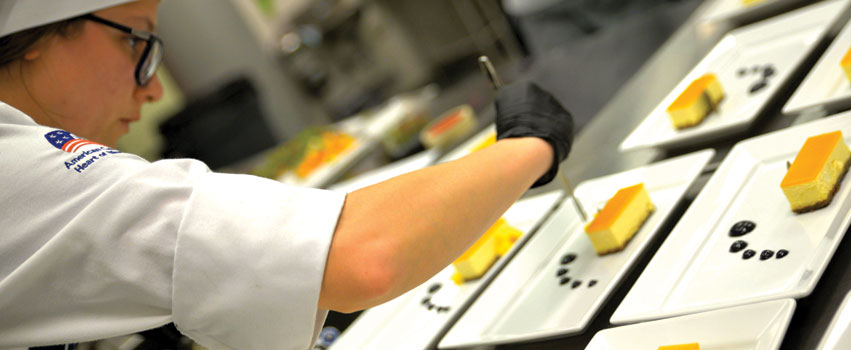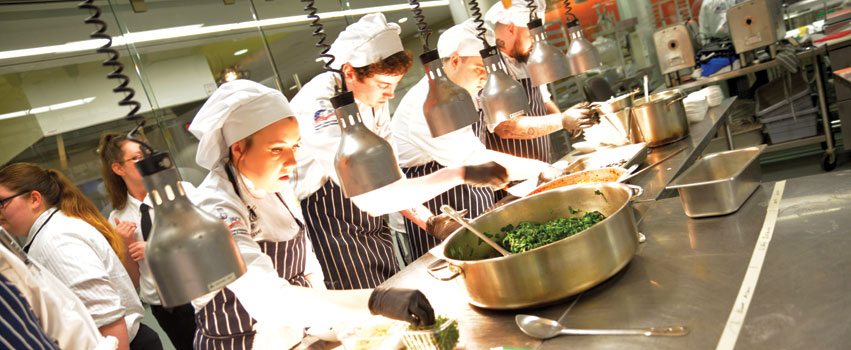The field of culinary arts has quickly become one of great importance in American society. To keep up with this rapidly growing industry, South Side Mission and Illinois Central College offer excellent programs right here in Peoria for those with a passion for creating tasty masterpieces.
The two programs are quite different, so prospective chefs can enroll in the one which best suits their abilities and helps achieve their personal goals. Despite their differences, both programs graduate highly qualified men and women, with either an associate’s degree or a certificate in culinary arts, who most often join kitchen staffs in the Peoria area.
A Culinary Mission
South Side Mission’s culinary training program is headed up by Chef Chris Franzoni, former executive chef at the Par-A-Dice. In the summer of 2004, Franzoni came across an ad in the paper for an executive chef and instructor opening. Although he wasn’t sure he wanted to be the instructor of a culinary school, he applied for the job and was subsequently hired to teach the Mission’s first culinary arts class. This February, its fourth class graduated, launching nine new chefs into the workforce.
Franzoni grew up in the kitchen—that’s where traditional Italian families such as his live! Though his initial degree was in elementary education, Franzoni discovered he didn’t really want to be a traditional teacher. He decided to do what he had always been good at—cooking—and attended the Cooking and Hospitality Institute of Chicago.
Fulfilling their Christian mission to serve the less fortunate, the culinary training program at South Side Mission gives men and women of all ages the opportunity to better themselves by feeding those who come to them. Two of its most recent graduates were also once residents of homeless shelters, including one who lived in the shelter at South Side Mission.
The Mission’s program is unique in that they will accept anyone who is committed to attending class from 8:30am to 3pm every day for 12 weeks and making a real effort to learn what is being taught. Students are not asked to pay much—just $100 to prove their commitment—money which goes toward a chef’s coat, workbook (textbooks are borrowed) and bus passes, if transportation is needed. Upon graduation, an anonymous donor supplies each new chef with his/her own set of professional chef knives.

Stories of Success
Because the Mission’s program isn’t at a typical location, the average person looking to become a chef might not even know it exists. Currently, word of mouth is the main form of advertisement, which works well, as Franzoni can only accept 10 students per session. Meg Newell, the Mission’s director of public relations and marketing, said, “This is an exceptional program in that it takes people who otherwise might not be success stories and it makes [them] success stories, and so we get quite a bit of attention because of that, which leads other people to us.”
Chris Jackson moved to Peoria all the way from Arkansas just to participate in the Mission’s culinary training program. His sister, La’Angela Pointer, graduated from the program and is now working for Eurest, a dining services company, in Caterpillar’s facility in Edwards. After witnessing his sister’s success, Jackson decided it was worth the move.
Franzoni noted that since the program began in September of 2006, several of his students have been soup kitchen patrons themselves. “They’ll see students in their coats and get curious,” he said, which leads to giving them an application so that they might have the same opportunity.
Renita Bailey is one such example. One day, Bailey went to the Mission’s Lighthouse Diner for lunch. Seeing the students in their chef coats prompted her to ask questions and apply to become a chef-in-training herself. She said that the family-oriented team atmosphere made the class more enjoyable than she ever thought it would be.
Teamwork in the Kitchen
Each day, Franzoni gives basic instructions in the classroom before the class moves to the kitchen for the day. There, students work together as a team to produce one large meal. Questions are addressed to peers before going to Franzoni, who monitors and corrects mistakes as necessary, always teaching how to do things better next time.
Marcus Evans, a student who has been in the hospitality industry for some time, said that he got more out of the class than he thought he would. “We learn theory—what we’re doing instead of just how to do it.” Franzoni agreed, saying he teaches theory because “if you learn how to make a recipe, you learn how to make one dish. If you learn techniques, you can apply them to whatever dish you’re making.”
All students agree on one thing: getting an honest response from those who eat at the soup kitchen helps them know how they’re doing. Bailey said, “The response I get from people every day shows me I will be successful.” Although it will take time, her goals are realistic: obtain an internship at an area restaurant and work her way up the food chain. After that, her dream is to open her own soul food restaurant.

End-to-End Commitment
Once students are accepted into the program, South Side commits to helping them from the first day they step into the Mission’s kitchen to their first day in an employment setting. Prospective chefs receive help from Peoria Jobs Partnership in writing resumes and learning interviewing skills. “We’re still looking for avenues of employment. That’s the ultimate goal,” Franzoni said. “We don’t just want to make them better cooks. A lot of these people need decent-paying jobs.”
Each student must become certified in sanitation practices by taking a course offered free of charge by a private consultant. This certification is usually required by companies in the food industry, giving the Mission’s graduates an edge with potential employers.
A Star at the Suites
David Schneider, now a front-of-house complimentary breakfast chef at Embassy Suites, is a perfect example of this commitment. A skilled electrician, Schneider sustained an injury on the job, making it impossible for him to continue in his trade. He found himself looking for a new profession that would allow him the time he wanted to spend with his family. He and his wife decided that his best option was to become a stay-at-home dad—a job that led him to cooking, which quickly became a passion. After seeing an ad for the Mission’s culinary school, Schneider signed up, hoping to polish his skills. “I was just a good cook…and I wanted to become a great cook,” he said.
The big-kitchen experience helped him do just that. Working in a team atmosphere prepared Schneider for his job at Embassy Suites, which he landed just two weeks after graduating from the program. He is so passionate about cooking that, even after cooking all day at work, he goes home to cook dinner for his family—and sometimes spends even more time in the kitchen after that.
Schneider’s case is yet another success story which illustrates the passion and commitment of both the Mission’s staff and its culinary students. And with this, there is little room for doubt or failure.
Community College Cooking
The Culinary Arts Management program at Illinois Central College differs from South Side Mission’s certificate program in nearly every way, from the time it takes to complete each class to the atmosphere in which students work. To graduate from ICC’s program with an associate’s degree, students must complete 70 credit hours and follow the prescribed order of requirements and electives—a goal a full-time student can meet in two years, according to Chef Instructor Charles Robertson.
Before joining the staff, Robertson had taken general education classes at ICC and earned his associate’s degree in culinary arts from Chicago’s Kendall College. He returned to Peoria to begin his career, working his way up from intern to executive chef at Lindsay’s on Liberty, and later holding the same position at the IVY Club in Peoria Heights. This August will be his fifth year teaching at ICC, and he “absolutely loves it!”
Chef Instructor Joy Ashwood has worked in the food industry all her life, receiving her original training from a single chef in his kitchen. “That’s how it was done then,” she explained. She decided to get a degree and attended ICC’s culinary arts program as a student herself when it was only part-time. Ashwood had worked as a teacher in the prison culinary training program for Spoon River College, “[teaching] classes that gave inmates a chance to learn skills that would hopefully lead to gainful employment when they were released from prison.” Her career at ICC began when they bought this program from Spoon River College.

A Full-Time Program
When the College opened its North Campus five years ago, the culinary arts became a full-time program. To ensure that kitchen labs are of a manageable size, just 12 students are allowed in each session. Classes meet for five hours, two days a week for eight weeks. All students must begin with CA 150—an introduction to culinary arts—which focuses on basic skills and techniques such as knife skills and making stocks, soups and starches. Robertson said this foundation of culinary arts is necessary before any specific skills are introduced.
The kitchen lab is designed to replicate a professional kitchen environment as closely as possible. Unlike the students at South Side Mission, ICC’s students work in small groups of two or three, each of which cooks the same meal. The students enrolled in ICC’s culinary arts program range from new high school graduates to older adults looking to start a second career. “It’s really cool that you can see an 18-year-old and a 40-year-old learning something they have a passion for side-by-side,” said Robertson.
One student, Charles Rogers, who has been cooking since he was old enough to get a job, said he thought the class would be more stressful than it is. He enjoys the time spent in the kitchen lab the most. “The best part is cooking—to see if you can get everything done in time, to see if [Ashwood] likes it—and eating the food after cooking it!”
Jill Dray, a student who has also worked in the food industry for some time, said of the class, “It’s at a faster pace and is harder than I thought it would be.” The greatest lesson she has learned is just how hectic working in a professional kitchen can be. And learning the basic skills, such as cooking techniques, the importance of exact measurements and knife skills, has taught her invaluable lessons.
Hopes for the Future
Prior to the acquisition of its North Campus, ICC only offered a culinary arts certificate program, which requires just 37 credit hours. Classes took place only when the school was able to find kitchens in which they could be held, as none of its campuses were equipped with a kitchen lab. While current accommodations are much improved, Ashwood said they still aren’t as big as the college now needs. ICC is currently looking to expand and build three kitchens, which would allow them to accept more students into the program. Currently, about 90 students are enrolled in its culinary program—which is just about the limit until more kitchens are added.
“We have an excellent program,” Ashwood noted. “It took a long time to get it up and running, but it’s affordable. We can offer more one-on-one instruction and more individual attention than larger culinary schools,” she said. Such attention is definitely felt by students like Dray and Rogers, who both agree that their experience in the kitchen labs will be of tremendous help when it comes time to work in a real kitchen.
Rogers enrolled in the program after his child was born, in an effort to better provide for his family. Initially, he began working in the food industry because it provided an easy job, but has since come to really enjoy his time in the kitchen. Upon graduation, Rogers hopes to obtain a job in an established kitchen, and entertains the notion of opening his own restaurant some day.
Dray said she has always enjoyed working in the food industry, and when she heard that ICC had a culinary arts program, she signed up. When she graduates, Dray hopes to obtain a job in catering. She also mentioned that she might like to have her own catering company one day, but has set her initial sights on working for someone else and paying her dues.
From the Lab to the Field
Bill Turney, a successful graduate of ICC’s culinary arts program, had a long-time career in manufacturing sales and management and just got tired of it. At his wife’s suggestion, he took a cooking class at ICC for fun and was quickly hooked. In 2004, Turney enrolled in the full-time culinary training program and was a member of the first class that was held at the North Campus.
In 2006—even before he graduated—Turney took another suggestion from his wife and opened From the Field Cooking School in Morton. Unlike many demonstration classes, which only allow students to observe, his school helps people improve their basic cooking skills by doing the cooking themselves and trying different styles of cooking. “It’s intimidating for people who don’t know how to cook,” he said, “so I show them that they can. My mom used to say, ‘If you can read, you can cook.’” Turney focuses primarily on teaching people how to cook food from scratch. While working twice as many hours and getting paid a fraction of what he did in the corporate world, he said he’s never been happier.
Working the Culinary Field
Thinking about entering the culinary field? It’s best to earn either a degree or certificate in culinary arts. Deciding between the two isn’t even that difficult. Do you already work in the food industry? If so, and you’d like to move up a bit in the ranks, a certificate program might best suit you. If you’d like to become executive chef in a relatively short amount of time, a degree program will get you well on your way. With the exemplary programs at South Side Mission and Illinois Central College, you can achieve your culinary goals, whatever they may be. a&s


